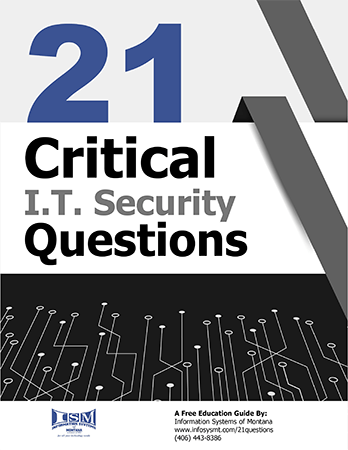Don’t Let Unpatched Systems Put Your Montana Medical Practice at Risk
Delayed updates open the door to HIPAA violations, patient data breaches, and costly ransomware attacks.
In private medical practices across Montana, patient care always comes first. But behind the scenes, technology is the backbone of every exam, billing cycle, and lab order. When that technology is outdated or left unpatched, the risk goes far beyond downtime, it can put patient data and HIPAA compliance on the line.
At Information Systems of Montana (ISM), we often see practices delay software or system updates out of fear they’ll disrupt workflows. Unfortunately, cybercriminals count on this hesitation. Unpatched systems are among the top causes of healthcare data breaches, and regulators take notice when sensitive health information is exposed.
Why Patch Management Matters in Healthcare
- Unpatched Vulnerabilities = Open Doors
The Cybersecurity & Infrastructure Security Agency (CISA) tracks the most exploited vulnerabilities across industries. Nearly all of them have available patches, but many healthcare providers delay applying them.
Hackers actively scan for medical practices running outdated software or devices. Once inside, they can steal sensitive patient data, deploy ransomware, or move laterally across connected devices like lab systems and billing platforms.
- HIPAA Compliance at Risk
HIPAA’s Security Rule requires covered entities to protect electronic protected health information (ePHI). Failure to apply available security updates is considered a violation of this rule.
The U.S. Department of Health & Human Services (HHS) has fined providers millions of dollars for breaches tied directly to unpatched systems. In one case, a medical center was penalized after hackers exploited an outdated operating system, exposing over 60,000 patient records. Regulators take a hard line: patches are not optional, they are expected.
- Patient Trust on the Line
When patients share their most personal details—medical histories, diagnoses, and financial data, they trust your practice to keep it private. A breach caused by unpatched systems not only triggers regulatory penalties but can also erode patient confidence.
According to the Ponemon Institute’s 2023 Cost of a Data Breach Report, the average healthcare data breach costs over $10 million, the highest of any industry. But beyond financial losses, many practices experience patient attrition after a breach. Once trust is broken, rebuilding it can take years.
- Insurance & Liability Issues
Cyber insurers increasingly require proof of regular patching and updates. Practices that can’t provide documentation may face:
- Denied claims after a breach
- Higher premiums at renewal
- Reduced coverage limits
What’s more, if patient lawsuits follow a breach, failure to patch known vulnerabilities may be seen as negligence, increasing liability.
Real-World Risks for Private Medical Practices
These risks aren’t theoretical; they’re happening every day in healthcare settings across the U.S.:
- Ransomware Attacks: In 2023, the FBI’s Internet Crime Complaint Center (IC3) reported that healthcare was the top industry targeted by ransomware gangs, often through unpatched vulnerabilities.
- Medical Device Risks: Network-connected imaging equipment and diagnostic devices often run outdated firmware. Once compromised, attackers can use them as a gateway to access patient records.
- Billing System Failures: Old practice management or billing software without updates exposes sensitive insurance, Medicare, and financial data to cyber theft.
- Third-Party Vendor Risks: If your EHR vendor or billing platform delays patches, your practice may still be held accountable under HIPAA for resulting breaches.
The Hidden Costs of Delaying Patches
Delaying updates may feel safer in the moment, but it comes with long-term consequences:
- Increased Downtime – Attacks targeting unpatched systems often lock practices out of EMRs and lab systems, halting patient care.
- Emergency IT Costs – Recovering from a breach or ransomware attack costs far more than scheduled maintenance.
- Lost Revenue – Every hour of downtime translates to missed appointments and delayed billing.
- Regulatory Fines – HIPAA penalties can range from $100 to $50,000 per violation, per record exposed.
The cost of downtime and compliance failures far outweighs the brief inconvenience of applying updates correctly.
How Montana Medical Practices Can Stay Secure
- Automate Updates Where Possible
Use patch management tools to ensure updates are applied consistently across all workstations, servers, and connected devices. Automation reduces the risk of human error or oversight.
- Schedule Maintenance Windows
To minimize disruption, plan patching during evenings or weekends. Communicate with staff so they know when systems may be temporarily unavailable.
- Test Critical Patches First
For sensitive systems like EMRs or medical devices, test updates in a controlled environment before rolling them out practice-wide. This ensures compatibility while still maintaining security.
- Document & Audit
Maintain detailed records of patch cycles and updates. This documentation not only supports internal accountability but also demonstrates HIPAA compliance if audited.
- Work with a Healthcare-Savvy IT Partner
Healthcare IT requires specialized knowledge. At ISM, we understand the balance between patient care and regulatory compliance. We help Montana medical practices:
- Maintain HIPAA compliance
- Minimize downtime during updates
- Automate patch management
- Secure both workstations and medical devices
- Document IT practices for insurance and audit readiness
Protect Patients, Protect Your Practice
Your patients count on you for care, and they trust you to protect their most sensitive information. Don’t let unpatched systems be the reason that trust is broken.
With nearly 30 years of IT and cybersecurity experience, ISM helps private medical practices across Montana stay HIPAA compliant, minimize downtime, and safeguard patient trust.
Schedule a free Technology Health Check with ISM and make sure your practice is secure, compliant, and patient-ready.

